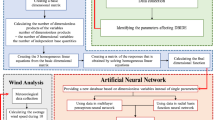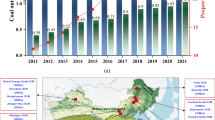Abstract
Dust is one of the most significant challenges in the mining industry, which adversely impacts the environment and human health. This research develops a hybrid approach based on dimensional analysis and regression analysis (H-DAMRA) methods to predict dust emission distance due to the bench-blasting in a limestone surface mining located in West Azerbaijan, northwest of Iran. Twelve effective variables including hole diameter, number of holes, delay timing, stemming, charge per delay, air humidity, air temperature, wind speed, wind direction, atmospheric pressure, powder factor, and blasted rock per hole were considered to model dust emission distance. According to the correlation analysis, powder factor, charge per delay, air humidity, and stemming have the highest correlation with the dust emission distance. In the dimensional analysis phase, the utmost influential factors in predicting the blast-induced dust emission distance were determined. As a result, several dimensionless outputs were obtained to be the dependent variables for regression analysis. Different multivariate regression models, including linear, nonlinear, logarithmic, and exponential regression, based on the dimensional analysis outputs, were developed and the performance of the models was evaluated using R2, RMSE, MAE, MRE, and VAF indices containing 100 in situ blasting rounds (100 data sample). The non-linear multivariate mixed regression model constructed on the dimensionless variables had the highest accuracy and the lowest error with a coefficient of determination of 93.57 percent. In addition, the results of the sensitivity analysis between input and output variables indicated that the dimensionless variables of “atmospheric pressure / (powder factor × stemming)” and “air humidity” with the values of 0.951 and 0.691 had the greatest and the lowest effect on dust emission distance, respectively.







Similar content being viewed by others
References
Abdollahisharif J, Bakhtavar E, Nourizadeh H (2016a) Monitoring and assessment of pollutants resulting from bench-blasting operations. J Min Environ 7(1):109–118
Abdollahisharif J, Bakhtavar E, Nourizadeh H (2016b) Green biocompatible approach to reduce the toxic gases and dust caused by theblasting in surface mining. Environmental Earth Sciences 75(3):191. https://doi.org/10.1007/s12665-015-4947-9
Abdul-Wahab SA, Bakheit CS, Al-Alawi SM (2005) Principal component and multiple regression analysis in modelling of ground-level ozone and factors affecting its concentrations. Environ Model Softw 20:1263–1271
Armaghani DJ, Hajihassani M, Marto A, Faradonbeh RS, Mohamad ET (2015) Prediction of blast-induced air overpressure: a hybrid AI-based predictive model. Environ Monit Assess 187(11):1–13
Armaghani DJ, Hajihassani M, Mohamad ET, Marto A, Noorani SA (2014) Blasting-induced flyrock and ground vibration prediction through an expert artificial neural network based on particle swarm optimization. Arab J Geosci 7:5383–5396
Armaghani DJ, Hajihassani M, Monjezi M, Mohamad ET, Marto A, Moghaddam MR (2015) Application of two intelligent systems in predicting environmental impacts of quarry blasting. Arab J Geosci 8(11):9647–9665
Armaghani DJ, Hajihassani M, Sohaei H, Mohamad ET, Marto A, Motaghedi H, Moghaddam MR (2015) Neuro-fuzzy technique to predict air-overpressure induced by blasting. Arab J Geosci 8(12):10937–10950
Armaghani DJ, Mohamad ET, Hajihassani M, Abad SANK, Marto A, Moghaddam MR (2016) Evaluation and prediction of flyrock resulting from blasting operations using empirical and computational methods. Eng Comput 32(1):109–121
Asif Z, Chen Z, Zhu ZH (2019) An integrated life cycle inventory and artificial neural network model for mining air pollution management. Int J Environ Sci Technol 16:1847–1856
Bakhtavar E, Hosseini S, Hewage K, Sadiq R (2021) Green blasting policy: simultaneous forecast of vertical and horizontal distribution of dust emissions using artificial causality-weighted neural network. J Clean Prod 283:124562
Bakhtavar E, Hosseini S, Hewage K, Sadiq R (2021) Air pollution risk assessment using a hybrid fuzzy intelligent probability-based approach: mine blasting dust impacts. Nat Resour Res 30(3):2607–2627
Bakhtavar E, Khoshrou H, Badroddin M (2015) Using dimensional-regression analysis to predict the mean particle size of fragmentation by blasting at the Sungun copper mine. Arab J Geosci 8:2111–2120. https://doi.org/10.1007/s12517-013-1261-2
Bakhtavar E, Nourizadeh H, Sahebi AA (2017) Toward predicting blast-induced flyrock: a hybrid dimensional analysis fuzzy inference system. Int J Environ Sci Technol 14:717–728. https://doi.org/10.1007/s13762-016-1192-z
Bator R, Sieniutycz S (2006) Application of artificial neural network for emission prediction of dust pollutants. Int J Energy Res 30:1023–1036. https://doi.org/10.1002/er.1200
Curren AM (2019) Dimensional analysis for Meds: refocusing on essential metric calculations. Jones & Bartlett Learning 296(5):7
Dehghani H, Pourzafar M (2021) Prediction and minimization of blast-induced flyrock using gene expression programming and cuckoo optimization algorithm. Environ Earth Sci 80:1–17
Ghasemi E, Amini H, Ataei M, Khalokakaei R (2012) Application of artificial intelligence techniques for predicting the flyrock distance caused by blasting operation. Arab J Geosci 7:193–202. https://doi.org/10.1007/s12517-012-0703-6
Ghasemi E, Sari M, Ataei M (2012) Development of an empirical model for predicting the effects of controllable blasting parameters on flyrock distance in surface mines. Int J Rock Mech Min Sci 52:163–170. https://doi.org/10.1016/j.ijrmms.2012.03.011
Gibbings, J.C (2011) Dimensional analysis. Springer Science & Business Media.
Gibbings JC (2011) Dimensional analysis. Springer Science & Business Media
Gokhale BV (2010) Rotary drilling and blasting in large surface mines. CRC Press 1(744):11. https://doi.org/10.1201/b10972
Hajihassani M, Armaghani DJ, Monjezi M, Mohamad ET, Marto A (2015) Blast-induced air and ground vibration prediction: a particle swarm optimization-based artificial neural network approach. Environ Earth Sci 74(4):2799–2817
Hajihassani M, Armaghani DJ, Sohaei H, Mohamad ET, Marto A (2014) Prediction of airblast-overpressure induced by blasting using a hybrid artificial neural network and particle swarm optimization. Appl Acoust 80:57–67
Hosseini S, Monjezi M, Bakhtavar E (2021) Mousavi A (2021) Prediction of dust emission due to open pit mine blasting using a hybrid artificial neural network. Nat Resour Res 30:4773–4788. https://doi.org/10.1007/s11053-021-09930-5
Kumar P, Bhandari S (2002) Modelling of near source dust dispersal after surface mine blast in weak wind over undulated terrain in tropical conditions, in:Proceedings of APCOM 2001. Society for Mining, Metallurgy and Exploration, Littleton, CO. 677–685
Monjezi M, Ahmadi Z, Varjani AY, Khandelwal M (2013) Backbreak prediction in the Chadormalu iron mine using artificial neural network. Neural Comput Appl 23:1101–1107
Monjezi M, Ghafurikalajahi M, Bahrami A (2011) Prediction of blast-induced ground vibration using artificial neural networks. Tunn Undergr Sp Technol 26:46–50
Nguyen H, Bui X-N, Tran Q-H, Moayedi H (2019) Predicting blast-induced peak particle velocity using BGAMs, ANN and SVM: a case study at the Nui Beo open-pit coal mine in Vietnam. Environ Earth Sci 78:1–14
Nourani V, Gökçekuş H, Umar IK (2020) Artificial intelligence based ensemble model for prediction of vehicular traffic noise. Environ Res. https://doi.org/10.1016/j.envres.2019.108852
Raajasubramanian D, Sundaramoorthy P, Baskaran L, Ganesh KS, Chidambaram ALA (2011) Effect of cement dust pollution on germination and growth of groundnut ( Arachis hypogaea L.). Multidiscip Res 25–30
Roy S, Adhikari GR, Renaldy TA, Jha AK (2011) Development of multiple regression and neural network models for assessment of blasting dust at a large surface coal mine. J Environ Sci Technol 4:284–301
Roy S, Adhikari GR, Singh TN (2010) Development of emission factors for quantification of blasting dust at surface. J Environ Prot (Irvine, Calif.) 1:346
Roy S, Singh T (2008) Influence of rock and explosives properties and blast design parameters on dust generation during blasting in opencast coal mines—an approach. Min Eng J 10:14–25
Sanchidrián JA, Ouchterlony F (2016) A distribution-free description of fragmentation by blasting based on dimensional analysis. Rock Mech Rock Eng 50:781–806. https://doi.org/10.1007/s00603-016-1131-9
Trivedi R, Singh TN, Raina AK (2014) Prediction of blast-induced flyrock in Indian limestone mines using neural networks. J Rock Mech Geotech Eng 6:447–454
Vignaux G (1988) An approximate inventory model based on dimensional analysis. Asia-Pac J Oper Res 5:117–123
White KJ (1992) The Durbin-Watson test for autocorrelation in nonlinear models. Rev Econ Stat 74(2):370–373
Yang Y, Zhang Q (1997) A hierarchical analysis for rock engineering using artificial neural networks. Rock Mech Rock Eng 30:207–222
Yilmaz I, Yuksek G (2009) Prediction of the strength and elasticity modulus of gypsum using multiple regression, ANN, and ANFIS models. Int J Rock Mech Min Sci. https://doi.org/10.1016/j.ijrmms.2008.09.002
Zeinalnezhad M, Chofreh AG, Goni FA, Klemeš JJ, Darvishvand AM, Vashaghi K (2019) Forecasting air pollution by adaptive neuro fuzzy inference system, in: 2019 4th International conference on smart and sustainable technologies (SpliTech). IEEE, pp. 1–3. https://doi.org/10.23919/SpliTech.2019.8783075
Zohuri B (2017) Dimensional analysis beyond the Pi theorem; Springer: Cham. Switzerland 2017. https://doi.org/10.1007/978-3-319-45726-0
Acknowledgements
The authors would like to appreciate the help of Mr. Ahmadi from Asgarabad 2 mine in collecting the dataset.
Author information
Authors and Affiliations
Corresponding author
Ethics declarations
Competing interest
The authors declare no competing interests.
Additional information
Responsible Editor: Amjad Kallel
Highlights
• We developed several statistical models to predict dust emission distance in surface mines.
• The dimensional analysis technique is employed to reduce the variable dimensions.
• We presented a new procedure for dust prediction due to mine blasting in an environmentally friendly policy.
Rights and permissions
About this article
Cite this article
Hosseini, S., Mousavi, A. & Monjezi, M. Prediction of blast-induced dust emissions in surface mines using integration of dimensional analysis and multivariate regression analysis. Arab J Geosci 15, 163 (2022). https://doi.org/10.1007/s12517-021-09376-2
Received:
Accepted:
Published:
DOI: https://doi.org/10.1007/s12517-021-09376-2




